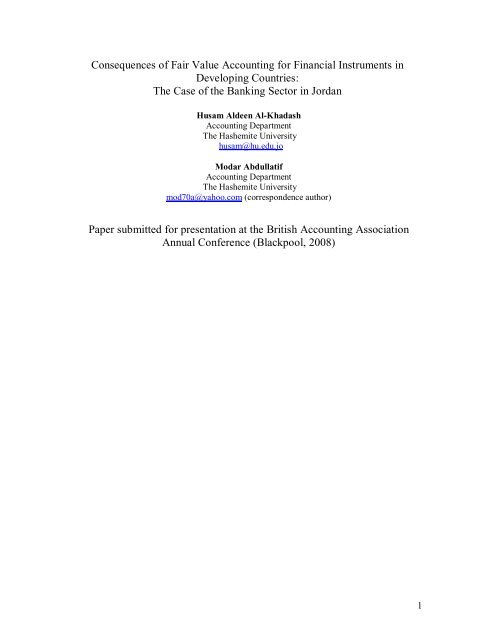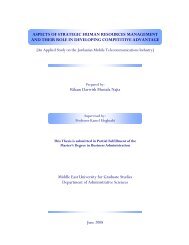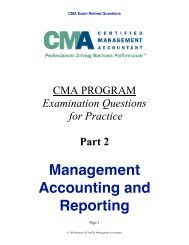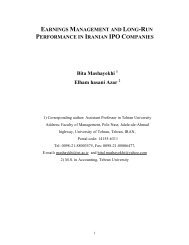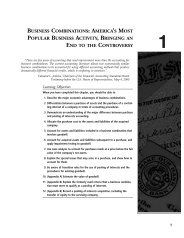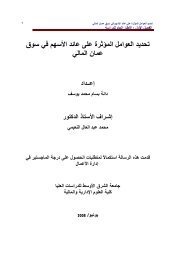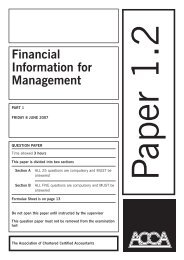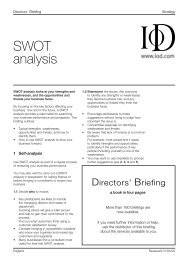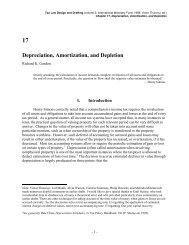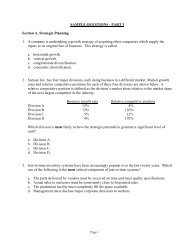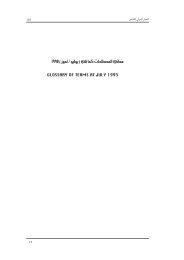Consequences of Fair Value Accounting for Financial Instruments in ...
Consequences of Fair Value Accounting for Financial Instruments in ...
Consequences of Fair Value Accounting for Financial Instruments in ...
Create successful ePaper yourself
Turn your PDF publications into a flip-book with our unique Google optimized e-Paper software.
<strong>Consequences</strong> <strong>of</strong> <strong>Fair</strong> <strong>Value</strong> <strong>Account<strong>in</strong>g</strong> <strong>for</strong> <strong>F<strong>in</strong>ancial</strong> <strong>Instruments</strong> <strong>in</strong><br />
Develop<strong>in</strong>g Countries:<br />
The Case <strong>of</strong> the Bank<strong>in</strong>g Sector <strong>in</strong> Jordan<br />
Husam Aldeen Al-Khadash<br />
<strong>Account<strong>in</strong>g</strong> Department<br />
The Hashemite University<br />
husam@hu.edu.jo<br />
Modar Abdullatif<br />
<strong>Account<strong>in</strong>g</strong> Department<br />
The Hashemite University<br />
mod70a@yahoo.com (correspondence author)<br />
Paper submitted <strong>for</strong> presentation at the British <strong>Account<strong>in</strong>g</strong> Association<br />
Annual Conference (Blackpool, 2008)<br />
1
Abstract<br />
The <strong>in</strong>troduction <strong>of</strong> International <strong>F<strong>in</strong>ancial</strong> Report<strong>in</strong>g Standards, mandatory <strong>for</strong> many listed companies <strong>in</strong><br />
develop<strong>in</strong>g countries, has proven to be a challenge <strong>for</strong> preparers and academicians alike, given the<br />
standards' emphasis on fair value as measures to improve the true and fair presentation <strong>of</strong> the f<strong>in</strong>ancial<br />
statements. This study aims to provide evidence to describe the effect <strong>of</strong> implement<strong>in</strong>g fair value<br />
measurements <strong>of</strong> f<strong>in</strong>ancial <strong>in</strong>struments on the f<strong>in</strong>ancial per<strong>for</strong>mance <strong>of</strong> a firm and its earn<strong>in</strong>g per share<br />
(EPS). It also tests the relationship between the abnormal return <strong>of</strong> stocks and <strong>in</strong>come calculated <strong>in</strong> two<br />
ways: Income conta<strong>in</strong><strong>in</strong>g unrealized hold<strong>in</strong>g ga<strong>in</strong>s and losses, and <strong>in</strong>come not conta<strong>in</strong><strong>in</strong>g such hold<strong>in</strong>g<br />
ga<strong>in</strong>s and losses. The study sample comprises Jordanian commercial and <strong>in</strong>vestment banks, and covers the<br />
period <strong>of</strong> 2002-2006.<br />
This study f<strong>in</strong>ds that f<strong>in</strong>ancial per<strong>for</strong>mance <strong>of</strong> a bank is generally very significantly affected by valu<strong>in</strong>g<br />
f<strong>in</strong>ancial <strong>in</strong>struments at fair values. It also f<strong>in</strong>ds that there is a positive and extremely high value <strong>of</strong><br />
Earn<strong>in</strong>gs per Share (EPS) when implement<strong>in</strong>g the fair values <strong>in</strong> evaluat<strong>in</strong>g the f<strong>in</strong>ancial <strong>in</strong>struments,<br />
compared to when <strong>in</strong>come is calculated without add<strong>in</strong>g hold<strong>in</strong>g ga<strong>in</strong>s and losses. In addition, the study<br />
analyzes abnormal returns around the date <strong>of</strong> earn<strong>in</strong>gs announcement. F<strong>in</strong>d<strong>in</strong>gs <strong>in</strong>dicate that there is no<br />
significant difference <strong>in</strong> the abnormal return if the net <strong>in</strong>come is calculated with or without consider<strong>in</strong>g fair<br />
values <strong>of</strong> f<strong>in</strong>ancial <strong>in</strong>struments, although this f<strong>in</strong>d<strong>in</strong>g is significantly different when the effects <strong>of</strong> the 2005<br />
and 2006 years (the so called economic bubble years) are removed. The study concludes with question<strong>in</strong>g<br />
the suitability <strong>of</strong> the worldwide application <strong>of</strong> IFRS <strong>for</strong> fair value account<strong>in</strong>g measurement<br />
Keywords: <strong>Fair</strong> value account<strong>in</strong>g, f<strong>in</strong>ancial <strong>in</strong>struments, banks, abnormal returns, pr<strong>of</strong>it,<br />
IAS 39, EPS, Jordan.<br />
1. Introduction<br />
<strong>Account<strong>in</strong>g</strong> standards setters <strong>in</strong> many countries around the world have issued standards<br />
requir<strong>in</strong>g recognition <strong>of</strong> some balance sheet amounts at fair value, and recognition <strong>of</strong><br />
changes <strong>in</strong> their fair values <strong>in</strong> <strong>in</strong>come or <strong>in</strong> stockholders' equity. In addition, many other<br />
balance sheet amounts have been made subject to partial application <strong>of</strong> fair value rules<br />
that depend on various ad hoc circumstances, <strong>in</strong>clud<strong>in</strong>g impairment and use <strong>of</strong> a<br />
derivative to hedge changes <strong>in</strong> fair value. The <strong>F<strong>in</strong>ancial</strong> <strong>Account<strong>in</strong>g</strong> Standards Board and<br />
2
the International <strong>Account<strong>in</strong>g</strong> Standards Board (hence<strong>for</strong>th FASB and IASB) are also<br />
work<strong>in</strong>g jo<strong>in</strong>tly on projects exam<strong>in</strong><strong>in</strong>g expand<strong>in</strong>g the use <strong>of</strong> fair values <strong>in</strong> account<strong>in</strong>g.<br />
Although fair value account<strong>in</strong>g has been defended on the grounds <strong>of</strong> be<strong>in</strong>g more relevant<br />
<strong>for</strong> <strong>in</strong>vestment decisions, a cost to <strong>in</strong>vestors potentially aris<strong>in</strong>g from its use is that many<br />
recognized f<strong>in</strong>ancial <strong>in</strong>struments might not be measured with sufficient precision to help<br />
them assess adequately the firm’s f<strong>in</strong>ancial position and earn<strong>in</strong>gs potential. This<br />
reliability cost is compounded by the problem that <strong>in</strong> the absence <strong>of</strong> active markets <strong>for</strong> a<br />
particular f<strong>in</strong>ancial <strong>in</strong>strument, management must estimate its fair value, an issue that can<br />
be subject to discretion or manipulation.<br />
This paper discusses and tests economic consequences <strong>of</strong> the application <strong>of</strong> fair value<br />
account<strong>in</strong>g (<strong>in</strong> particular International <strong>Account<strong>in</strong>g</strong> Standard - IAS 39) <strong>in</strong> the context <strong>of</strong> a<br />
develop<strong>in</strong>g country, Jordan. The ma<strong>in</strong> application <strong>of</strong> IAS 39 <strong>in</strong> Jordan is <strong>for</strong> <strong>in</strong>vestment<br />
security portfolios, especially by banks, which have been required by Jordanian laws to<br />
use International <strong>F<strong>in</strong>ancial</strong> Report<strong>in</strong>g Standards (hence<strong>for</strong>th IFRS) <strong>in</strong> external f<strong>in</strong>ancial<br />
report<strong>in</strong>g s<strong>in</strong>ce 1998.<br />
The effects <strong>of</strong> apply<strong>in</strong>g fair value account<strong>in</strong>g <strong>for</strong> f<strong>in</strong>ancial <strong>in</strong>struments on earn<strong>in</strong>gs,<br />
equity, and stock prices are generally well-documented <strong>in</strong> studies based on USA data,<br />
where the issue was dom<strong>in</strong>ant <strong>in</strong> the 1990s, and are also documented <strong>in</strong> some European<br />
Union countries, where the nature <strong>of</strong> the traditional cont<strong>in</strong>ental European account<strong>in</strong>g<br />
systems have made the problem <strong>of</strong> adoption <strong>of</strong> IFRS, <strong>in</strong>clud<strong>in</strong>g fair value account<strong>in</strong>g<br />
standards, an arguably larger problem caus<strong>in</strong>g more economic consequences than that <strong>in</strong><br />
the USA or the UK.<br />
Given the magnitude <strong>of</strong> the complications <strong>of</strong> apply<strong>in</strong>g fair value account<strong>in</strong>g <strong>in</strong> moredeveloped<br />
countries, this study seeks to contribute to our knowledge on this issue by<br />
study<strong>in</strong>g it <strong>in</strong> a develop<strong>in</strong>g country, with a much smaller economy and a much less<br />
efficient f<strong>in</strong>ancial market, where the consequences <strong>of</strong> such an application would be<br />
possibly relatively higher. This paper there<strong>for</strong>e discusses and tests the effect <strong>of</strong><br />
3
implement<strong>in</strong>g fair value account<strong>in</strong>g <strong>for</strong> f<strong>in</strong>ancial <strong>in</strong>struments on the Jordanian banks'<br />
<strong>in</strong>come, Earn<strong>in</strong>g Per Share (EPS) and the abnormal return <strong>of</strong> stocks. This concludes by<br />
discuss<strong>in</strong>g how appropriate the application <strong>of</strong> such an <strong>in</strong>ternational f<strong>in</strong>ancial report<strong>in</strong>g<br />
approach, as adopted by the IASB, might be <strong>in</strong> different contexts.<br />
2. Theoretical Background<br />
Replac<strong>in</strong>g traditional historical cost account<strong>in</strong>g measures with measures based on fair<br />
values has been considered a controversial issue, or even a paradigm shift (Barlev and<br />
Haddad, 2003). Several arguments have been put <strong>for</strong>ward <strong>in</strong> support or aga<strong>in</strong>st the<br />
application <strong>of</strong> fair value account<strong>in</strong>g <strong>in</strong> practice.<br />
This section beg<strong>in</strong>s by discuss<strong>in</strong>g the def<strong>in</strong>ition <strong>of</strong> fair value as used <strong>in</strong> account<strong>in</strong>g. It<br />
then discusses arguments <strong>for</strong> and aga<strong>in</strong>st the application <strong>of</strong> fair value account<strong>in</strong>g, and the<br />
role <strong>of</strong> <strong>in</strong>ternational adoption or convergence with IFRS <strong>in</strong> the <strong>in</strong>ternational spread <strong>of</strong><br />
issues related to fair value account<strong>in</strong>g, especially those issues related to IAS 39.<br />
2.1 Def<strong>in</strong>ition <strong>of</strong> <strong>Fair</strong> <strong>Value</strong> as Applied <strong>in</strong> <strong>Account<strong>in</strong>g</strong><br />
Accord<strong>in</strong>g to IAS 39 (paragraph 9) fair value is def<strong>in</strong>ed as:<br />
'the amount <strong>for</strong> which an asset could be exchanged, or a<br />
liability settled, between knowledgeable, will<strong>in</strong>g parties <strong>in</strong> an<br />
arm's length transaction'<br />
In the USA, the most recent SFAS 157 (paragraph 5) def<strong>in</strong>ed fair value as:<br />
'the price that would be received to sell an asset or paid to<br />
transfer a liability <strong>in</strong> an orderly transaction between market<br />
participants at the measurement date'<br />
We can see that both the IASB and the FASB def<strong>in</strong>itions are basically equivalent, despite<br />
different word<strong>in</strong>g (Hitz, 2007; Turel, 2007).<br />
However, these def<strong>in</strong>itions require a closer look when try<strong>in</strong>g to apply them <strong>in</strong> practice.<br />
For example, Barth and Landsman (1995) argue that the def<strong>in</strong>itions can be applied <strong>in</strong> a<br />
sett<strong>in</strong>g <strong>of</strong> perfect and complete markets, while <strong>in</strong> fact there are several different<br />
4
alternative fair value constructs. <strong>Account<strong>in</strong>g</strong> theorists have argued <strong>in</strong> favor <strong>of</strong> several<br />
different measures <strong>of</strong> fair value, <strong>in</strong>clud<strong>in</strong>g current cost account<strong>in</strong>g based on entry prices,<br />
exit price account<strong>in</strong>g, and current purchas<strong>in</strong>g power account<strong>in</strong>g (also known as general<br />
price level account<strong>in</strong>g) (Deegan and Unerman, 2006).<br />
The application <strong>of</strong> fair value account<strong>in</strong>g follows a three-tier hierarchy, where first market<br />
prices are applied as a best estimate <strong>of</strong> fair value. If market prices are not available or do<br />
not exhibit sufficient quality, quoted market prices <strong>of</strong> comparable items are considered. If<br />
this also does not work, fair value is applied by <strong>in</strong>ternal estimation (Hitz, 2007). This<br />
illustration is generally equivalent to that described <strong>in</strong> more detail <strong>in</strong> IAS 39 (see<br />
Alfredson et al, 2007).<br />
2.2 Arguments <strong>for</strong> the Application <strong>of</strong> <strong>Fair</strong> <strong>Value</strong> <strong>Account<strong>in</strong>g</strong><br />
<strong>Account<strong>in</strong>g</strong> theory literature is full <strong>of</strong> arguments by account<strong>in</strong>g scholars claim<strong>in</strong>g that<br />
historical cost account<strong>in</strong>g is obsolete and irrelevant <strong>for</strong> f<strong>in</strong>ancial decision-mak<strong>in</strong>g, and<br />
there<strong>for</strong>e needs to be replaced by some <strong>for</strong>m or another <strong>of</strong> fair value account<strong>in</strong>g.<br />
Accord<strong>in</strong>g to its opponents, ma<strong>in</strong> deficiencies associated with historical cost account<strong>in</strong>g<br />
<strong>in</strong>clude its irrelevance dur<strong>in</strong>g <strong>in</strong>flation periods (Deegan and Unerman, 2006), its failure to<br />
recognize unrealized <strong>in</strong>creases <strong>in</strong> values <strong>of</strong> assets, and its lack <strong>of</strong> comparability (Riahi-<br />
Belkaoui, 2004).<br />
Given that, the use <strong>of</strong> fair values was proposed as an alternative to historical cost<br />
measures. In the particular case <strong>of</strong> f<strong>in</strong>ancial <strong>in</strong>struments, fair value has generally been<br />
considered as more relevant than historical cost, and <strong>in</strong> many cases not much less<br />
reliable, especially if current market prices are readily available. <strong>Fair</strong> value measures <strong>of</strong><br />
f<strong>in</strong>ancial <strong>in</strong>struments have been seen as reflect<strong>in</strong>g the market's assessment <strong>of</strong> the effects<br />
<strong>of</strong> current economic conditions on the f<strong>in</strong>ancial <strong>in</strong>strument, not be<strong>in</strong>g affected by the past<br />
history <strong>of</strong> the f<strong>in</strong>ancial <strong>in</strong>strument or the specific enterprise that holds it (Carroll et al,<br />
2003), and allow<strong>in</strong>g adequate f<strong>in</strong>ancial statement reflection <strong>of</strong> asset liability management<br />
activities (if fair value account<strong>in</strong>g is applied to all f<strong>in</strong>ancial <strong>in</strong>struments) (Gebhardt et al,<br />
5
2004). It was also argued that fair value account<strong>in</strong>g measures, as compared to historical<br />
cost account<strong>in</strong>g, provides better <strong>in</strong>ternational account<strong>in</strong>g harmonization (Barlev and<br />
Haddad, 2007).<br />
Barth (2006) concludes that the perceived usefulness <strong>of</strong> fair value account<strong>in</strong>g by<br />
standard-setters has shifted the argument from whether they should be used <strong>in</strong> f<strong>in</strong>ancial<br />
statements to how they should be used <strong>in</strong> f<strong>in</strong>ancial statements. However, the application<br />
<strong>of</strong> fair value account<strong>in</strong>g has not been without criticism, notably from the bank<strong>in</strong>g<br />
<strong>in</strong>dustry. The follow<strong>in</strong>g subsection illustrates this issue.<br />
2.3 Arguments aga<strong>in</strong>st the Application <strong>of</strong> <strong>Fair</strong> <strong>Value</strong> <strong>Account<strong>in</strong>g</strong><br />
Although the concept <strong>of</strong> fair value measurement <strong>in</strong> account<strong>in</strong>g has been seen as relevant<br />
<strong>for</strong> <strong>in</strong>vestment decisions, it has been criticized on several grounds. These <strong>in</strong>clude the<br />
arguments that fair value measurements may lead to distortion <strong>of</strong> net <strong>in</strong>come through<br />
recognition <strong>of</strong> unrealized hold<strong>in</strong>g ga<strong>in</strong>s and losses, and that fair value measurements are<br />
not exact, are costly to generate, are subject to manipulation, and lead to break<strong>in</strong>g the<br />
historical cost model which is seen as well work<strong>in</strong>g and well understood (Evans, 2003).<br />
Benston (2005) argues that although the concept <strong>of</strong> us<strong>in</strong>g market values <strong>of</strong> assets and<br />
liabilities is theoretically sound, its implementation has been seriously flawed, such as <strong>in</strong><br />
the case <strong>of</strong> exclud<strong>in</strong>g held-to-maturity securities from revaluation, or <strong>in</strong> the case <strong>of</strong><br />
treat<strong>in</strong>g derivatives with fair values that may <strong>in</strong> many cases be calculated with substantial<br />
leeway by managers. Benston (2005) also argues that extend<strong>in</strong>g the use <strong>of</strong> fair value<br />
account<strong>in</strong>g to the level <strong>of</strong> revaluation <strong>for</strong> all assets would allow managers to record<br />
<strong>in</strong>come <strong>in</strong> advance <strong>of</strong> reliable evidence that it has been earned. This carries the risk <strong>of</strong><br />
be<strong>in</strong>g mislead<strong>in</strong>g due to be<strong>in</strong>g based on expectations that may turn out to be false<br />
(Rayman, 2007).<br />
In particular, a major vocal opponent <strong>of</strong> fair value account<strong>in</strong>g <strong>for</strong> f<strong>in</strong>ancial <strong>in</strong>struments<br />
has been the bank<strong>in</strong>g <strong>in</strong>dustry, which sought to provide several arguments aga<strong>in</strong>st fair<br />
6
value account<strong>in</strong>g, and even lobby aga<strong>in</strong>st its full application (Zeff, 2006). For example,<br />
the bank<strong>in</strong>g <strong>in</strong>dustry <strong>in</strong> the USA asserted that:<br />
"(1) Earn<strong>in</strong>gs numbers based on fair values <strong>for</strong> <strong>in</strong>vestment<br />
securities are likely to be more volatile, or variable, than those<br />
based on historical cost. Because this <strong>in</strong>creased volatility is not<br />
reflective <strong>of</strong> the underly<strong>in</strong>g economic volatility <strong>of</strong> banks'<br />
operations, <strong>in</strong>efficient capital allocation decisions will result, thus<br />
rais<strong>in</strong>g banks' cost <strong>of</strong> capital. (2) Us<strong>in</strong>g fair value account<strong>in</strong>g <strong>for</strong><br />
<strong>in</strong>vestment securities is likely to cause banks to violate regulatory<br />
capital requirements more <strong>of</strong>ten than is economically appropriate,<br />
result<strong>in</strong>g <strong>in</strong> excess regulatory <strong>in</strong>tervention or lead<strong>in</strong>g to costly<br />
actions by bank managers to reduce the risk <strong>of</strong> regulatory<br />
<strong>in</strong>tervention. ……….. (3) Because contractual cash flows are fixed<br />
<strong>for</strong> <strong>in</strong>vestments <strong>in</strong> debt securities held to maturity, changes <strong>in</strong> fair<br />
values <strong>of</strong> these securities are irrelevant <strong>for</strong> valu<strong>in</strong>g bank equity.<br />
Thus, such changes should not be a component <strong>of</strong> reported<br />
earn<strong>in</strong>gs." (Barth et al, 1995, p. 579).<br />
Anagnostopoulos and Buckland (2005) argue that banks aim at develop<strong>in</strong>g a portfolio <strong>of</strong><br />
bank<strong>in</strong>g transactions that would aim <strong>in</strong> the long term to ma<strong>in</strong>ta<strong>in</strong> <strong>in</strong>come and grow the<br />
customer base. This means that a bank generally cannot directly enjoy benefits from<br />
differences between carry<strong>in</strong>g and fair values <strong>of</strong> its portfolio, given that fair values do not<br />
rigidly bear a relation to contractual cash flows.<br />
In addition, confusion may result when some types <strong>of</strong> f<strong>in</strong>ancial <strong>in</strong>struments (such as some<br />
swaps) have zero historical cost, yet their current values may be very high and highly<br />
sensitive to <strong>in</strong>terest rates or exchange rates (Whitt<strong>in</strong>gton, 2005).<br />
A further problem was faced with the issue <strong>of</strong> <strong>in</strong>ternational harmonization <strong>of</strong> account<strong>in</strong>g<br />
and promot<strong>in</strong>g <strong>in</strong>ternational account<strong>in</strong>g standards worldwide. The <strong>in</strong>troduction <strong>of</strong> IFRS<br />
<strong>in</strong>to Europe (particularly IAS 39) caused strong objection from the bank<strong>in</strong>g <strong>in</strong>dustry<br />
(Larson and Street, 2004, Zeff, 2006). This caused the European Union to adopt IAS 39<br />
after exclud<strong>in</strong>g certa<strong>in</strong> sections from it, thus caus<strong>in</strong>g a major obstacle <strong>in</strong> its convergence<br />
with IFRS and a problem <strong>for</strong> auditors <strong>in</strong> terms <strong>of</strong> what particular f<strong>in</strong>ancial report<strong>in</strong>g<br />
standards to refer to <strong>in</strong> the auditor's report (Pacter, 2005).<br />
7
3. Empirical Evidence on the Application <strong>of</strong> <strong>Fair</strong> <strong>Value</strong> <strong>Account<strong>in</strong>g</strong><br />
Many empirical studies were undertaken on issues related to fair value account<strong>in</strong>g. These<br />
issues <strong>in</strong>clude the value-relevance <strong>of</strong> fair value measures on security prices, the<br />
comparison between effects <strong>of</strong> fair value account<strong>in</strong>g and historical cost account<strong>in</strong>g on<br />
security prices, earn<strong>in</strong>gs' changes and volatility result<strong>in</strong>g from the recognition <strong>of</strong><br />
unrealized hold<strong>in</strong>g ga<strong>in</strong>s and losses under fair value account<strong>in</strong>g, and the effect <strong>of</strong><br />
adopt<strong>in</strong>g fair value account<strong>in</strong>g as part <strong>of</strong> IFRS on capital markets, particularly outside<br />
North America. A discussion <strong>of</strong> some <strong>of</strong> these studies and their results is presented<br />
below.<br />
Studies cover<strong>in</strong>g the value-relevance <strong>of</strong> fair value account<strong>in</strong>g, measured by its<br />
<strong>in</strong>cremental effect over historical cost account<strong>in</strong>g on stock prices, have generally found<br />
that fair value estimates <strong>for</strong> <strong>in</strong>vestment securities are value-relevant and have significant<br />
explanatory power beyond that <strong>of</strong> historical cost measures (see <strong>for</strong> example Barth, 1994;<br />
Bernard et al, 1995; Barth et al, 1996; Barth and Cl<strong>in</strong>ch, 1998).<br />
As <strong>for</strong> earn<strong>in</strong>gs computed under fair value account<strong>in</strong>g, many studies have generally<br />
found that fair value earn<strong>in</strong>gs, result<strong>in</strong>g from recogniz<strong>in</strong>g unrealized hold<strong>in</strong>g ga<strong>in</strong>s and<br />
losses, are more volatile than those computed under historical cost account<strong>in</strong>g (Barth et<br />
al, 1995; Bernard et al, 1995). Hodder et al (2006) argue that <strong>in</strong>cremental earn<strong>in</strong>g<br />
volatility under fair value account<strong>in</strong>g <strong>in</strong>come is related to elements <strong>of</strong> risk not captured<br />
by historical cost account<strong>in</strong>g net <strong>in</strong>come or comprehensive <strong>in</strong>come, and that these risks<br />
relate more closely to capital market pric<strong>in</strong>g.<br />
Such value-relevance <strong>of</strong> fair value account<strong>in</strong>g measures has even been found under less<br />
efficient circumstances. Carroll et al (2003) argue that <strong>in</strong>cremental value-relevance <strong>of</strong> fair<br />
value account<strong>in</strong>g <strong>in</strong><strong>for</strong>mation is not elim<strong>in</strong>ated when an estimation <strong>of</strong> fair value <strong>for</strong> th<strong>in</strong><br />
markets' securities is needed. They f<strong>in</strong>d this result <strong>for</strong> both fair values <strong>of</strong> securities and<br />
fair-value-based ga<strong>in</strong>s and losses covered <strong>in</strong> their study <strong>of</strong> close-end mutual funds.<br />
8
However, this view has been countered by some results <strong>of</strong> studies where relatively<br />
different f<strong>in</strong>d<strong>in</strong>gs were reported. Eccher et al (1996) found that <strong>in</strong> some cases historical<br />
cost measures had <strong>in</strong>cremental value-relevance higher than those <strong>of</strong> fair value measures.<br />
Barth et al (1995) found that although fair value earn<strong>in</strong>gs are more volatile than historical<br />
cost earn<strong>in</strong>gs, <strong>in</strong>cremental volatility is not reflected <strong>in</strong> stock prices. In addition, Owusu-<br />
Ansah and Yeoh (2006) report no significant difference between recognition <strong>of</strong><br />
unrealized ga<strong>in</strong>s from revaluation <strong>of</strong> <strong>in</strong>vestment property <strong>in</strong> <strong>in</strong>come and recognition <strong>of</strong><br />
these ga<strong>in</strong>s <strong>in</strong> revaluation surplus. Nelson (1996) reports that fair values <strong>of</strong> <strong>in</strong>vestment<br />
securities have more <strong>in</strong>cremental power relative to book values, but that this result holds<br />
only <strong>for</strong> <strong>in</strong>vestment securities, and not <strong>for</strong> loans, deposits, or long-term debt.<br />
A relatively similar result was reported by Khurana and Kim (2003), who found that fair<br />
values <strong>of</strong> available-<strong>for</strong>-sale securities were more <strong>in</strong><strong>for</strong>mative than those <strong>of</strong> their book<br />
values. However, they found that <strong>for</strong> small bank hold<strong>in</strong>g companies and those with no<br />
analyst follow<strong>in</strong>g, fair value account<strong>in</strong>g measures <strong>for</strong> loans and deposits were less<br />
<strong>in</strong><strong>for</strong>mative than those <strong>of</strong> their historical cost account<strong>in</strong>g measures. They argue that this is<br />
possibly because loans and deposits are not actively traded and may <strong>in</strong> many cases<br />
<strong>in</strong>clude more subjectivity <strong>in</strong> estimat<strong>in</strong>g fair values. Khurana and Kim (2003) conclude<br />
that fair value measures are more value-relevant when there exists available objective<br />
market-determ<strong>in</strong>ed fair values. Apart from that, they argue that simply requir<strong>in</strong>g the use<br />
<strong>of</strong> fair value account<strong>in</strong>g is not appropriate <strong>for</strong> all cases.<br />
A note worth mention<strong>in</strong>g is that value-relevance <strong>of</strong> fair value measures and their effect on<br />
stock prices has not always been reported to be a positive issue. Indeed, several studies<br />
have found that fair value measures have caused negative stock price reactions. This is<br />
generally <strong>in</strong> the case <strong>of</strong> banks, given their relatively large proportion <strong>of</strong> <strong>in</strong>vestment<br />
securities to total assets, compared to other types <strong>of</strong> bus<strong>in</strong>esses. Cornett et al (1996) argue<br />
that new costs on banks result<strong>in</strong>g from fair value account<strong>in</strong>g announcements exceed<br />
benefits from reduc<strong>in</strong>g alleged ga<strong>in</strong>s-trad<strong>in</strong>g practices. Beatty et al (1996) report negative<br />
effects <strong>of</strong> stock price movements <strong>for</strong> banks as a result <strong>of</strong> fair value account<strong>in</strong>g. This was<br />
found to be most <strong>in</strong> the cases <strong>of</strong> banks more frequently trad<strong>in</strong>g their <strong>in</strong>vestments, hav<strong>in</strong>g<br />
9
longer maturity <strong>in</strong>vestments, and be<strong>in</strong>g more fully hedged aga<strong>in</strong>st <strong>in</strong>terest rate changes<br />
(Beatty et al, 1996).<br />
Indeed, the adoption <strong>of</strong> IFRS <strong>in</strong> the European Union, which <strong>in</strong>cluded adoption <strong>of</strong> fair<br />
value account<strong>in</strong>g through IAS 32 and IAS 39, had its effect on European capital markets.<br />
Armstrong et al (2006) report that European capital markets showed positive reaction to<br />
events <strong>in</strong>creas<strong>in</strong>g the likelihood <strong>of</strong> adopt<strong>in</strong>g IFRS, and negative reaction to events<br />
decreas<strong>in</strong>g that likelihood. They argue that <strong>in</strong>vestors prefer account<strong>in</strong>g harmonization and<br />
perceive that adoption <strong>of</strong> IFRS has benefits that outweigh its costs. Armstrong et al<br />
(2006) also f<strong>in</strong>d that this result holds <strong>for</strong> banks, despite widespread arguments that<br />
European Union banks oppose IAS 39.<br />
Lopes and Rodrigues (2007) f<strong>in</strong>d that, regard<strong>in</strong>g the disclosure level under IAS 32 and<br />
IAS 39, disclosure by Portuguese listed companies is related to size, auditor type, list<strong>in</strong>g<br />
status, and economic sector.<br />
Nevertheless, surveys by Larson and Street (2004) and Jermakowicz and Gornik-<br />
Tomaszewski (2006) showed that <strong>in</strong> Europe, IAS 32 and IAS 39 were seen as too<br />
complicated and complex <strong>in</strong> actual implementation, and that this is a significant barrier to<br />
IFRS convergence. Callao et al (2007), <strong>in</strong> a study on Spa<strong>in</strong>, f<strong>in</strong>d that the ma<strong>in</strong> difference<br />
between IFRS and Spanish account<strong>in</strong>g standards is the application <strong>of</strong> fair value<br />
account<strong>in</strong>g <strong>for</strong> f<strong>in</strong>ancial <strong>in</strong>struments, and that this leads to short-term worsened<br />
comparability and no improved relevance <strong>of</strong> f<strong>in</strong>ancial report<strong>in</strong>g to the local stock market.<br />
As <strong>for</strong> property, plant and equipment revaluation, they f<strong>in</strong>d no significant effect <strong>for</strong> that<br />
given that it is an optional practice that many companies rejected. However, Callao et al<br />
(2007) argue that improved relevance as a result <strong>of</strong> fair value account<strong>in</strong>g may occur <strong>in</strong><br />
the medium-term or long-term. In addition, Turel (2007) found that Turkish real estate<br />
<strong>in</strong>vestment trusts do not prefer valu<strong>in</strong>g <strong>in</strong>vestment properties at fair value under IAS 40.<br />
He argued that this is because <strong>of</strong> the effects <strong>of</strong> <strong>in</strong>come volatility.<br />
10
In a study <strong>of</strong> French Banks, Ben Hamida (2007) found that the market perceived adoption<br />
<strong>of</strong> IFRS and fair value account<strong>in</strong>g as harmful to the economic values <strong>of</strong> banks. She f<strong>in</strong>ds<br />
that announcements that signal an <strong>in</strong>creased (decreased) probability <strong>of</strong> IAS 39 adoption<br />
lead to negative (positive) abnormal stock price reactions.<br />
In summary, it appears that many studies have found that fair value account<strong>in</strong>g<br />
measurement <strong>for</strong> f<strong>in</strong>ancial <strong>in</strong>struments is value-relevant and significantly affects stock<br />
prices, although some studies have reported significant negative reactions from this<br />
account<strong>in</strong>g practice. Also, many studies have found <strong>in</strong>creased volatility <strong>of</strong> fair value<br />
earn<strong>in</strong>gs (result<strong>in</strong>g from recognition <strong>of</strong> unrealized hold<strong>in</strong>g ga<strong>in</strong>s and losses) compared to<br />
historical cost earn<strong>in</strong>gs, although the value-relevance <strong>of</strong> fair value earn<strong>in</strong>gs has generally<br />
not been documented as much as the value-relevance <strong>of</strong> fair value estimates <strong>of</strong> f<strong>in</strong>ancial<br />
<strong>in</strong>struments' values.<br />
However, a number <strong>of</strong> studies voiced concern about the application <strong>of</strong> fair value<br />
account<strong>in</strong>g <strong>for</strong> all f<strong>in</strong>ancial <strong>in</strong>struments or other balance sheet items, especially when no<br />
readily-determ<strong>in</strong>ed market values and active markets <strong>for</strong> trad<strong>in</strong>g exist.<br />
With the adoption <strong>of</strong> IFRS <strong>in</strong> the European Union, studies cont<strong>in</strong>ue to f<strong>in</strong>d many<br />
problems <strong>in</strong> adopt<strong>in</strong>g fair value account<strong>in</strong>g <strong>in</strong>ternational standards. These standards were<br />
accused <strong>of</strong> be<strong>in</strong>g too complex and complicated <strong>in</strong> actual account<strong>in</strong>g practice, and<br />
European Banks cont<strong>in</strong>ue to show concerns regard<strong>in</strong>g fair value account<strong>in</strong>g application.<br />
4. The Jordanian Bank<strong>in</strong>g Sector<br />
The establishment <strong>of</strong> banks <strong>in</strong> Jordan began <strong>in</strong> 1925, when the Ottoman Bank (a British<br />
commercial bank) was opened <strong>in</strong> Amman. After that, the Arab Bank opened its first<br />
branch <strong>in</strong> Amman <strong>in</strong> 1934, and, <strong>in</strong> 1949, transferred its headquarters to Amman. In 1949<br />
the British Bank <strong>for</strong> the Middle East began bus<strong>in</strong>ess <strong>in</strong> Jordan as the first <strong>for</strong>eign bank to<br />
operate <strong>in</strong> Jordan after <strong>in</strong>dependence. From 1955 until 1960 three new Jordanian<br />
commercial banks opened. The 1960s did not witness new bank establishments, but<br />
11
dur<strong>in</strong>g the 1970s a considerable number <strong>of</strong> new commercial banks, both Jordanian and<br />
<strong>for</strong>eign, began operat<strong>in</strong>g <strong>in</strong> Jordan. In addition, a number <strong>of</strong> <strong>in</strong>vestment banks, f<strong>in</strong>ancial<br />
<strong>in</strong>stitutions and specialized banks were opened, and there was an <strong>in</strong>crease <strong>in</strong> the number<br />
<strong>of</strong> branches <strong>of</strong> local banks (Aqel, 1993). These developments took place dur<strong>in</strong>g the<br />
economic boom <strong>of</strong> the 1970s and early 1980s, and the surge <strong>in</strong> the number <strong>of</strong> new banks<br />
and branches began to slow down dur<strong>in</strong>g the 1980s and 1990s.<br />
The Central Bank <strong>of</strong> Jordan (CBJ) was established <strong>in</strong> 1964, and it took the place <strong>of</strong> the<br />
Jordanian Currency Bureau. The CBJ manages the monetary policy <strong>of</strong> the country, leads<br />
the development <strong>of</strong> the bank<strong>in</strong>g system and monitors its per<strong>for</strong>mance (Aqel, 1993).<br />
The bank<strong>in</strong>g sector <strong>in</strong> Jordan has achieved high rates <strong>of</strong> growth and expansion. The<br />
number <strong>of</strong> banks operat<strong>in</strong>g <strong>in</strong> Jordan by the end <strong>of</strong> year 2006 is (23) banks. Of these, two<br />
claim Islamic bank<strong>in</strong>g and eight are <strong>for</strong>eign banks. These banks conduct bus<strong>in</strong>ess <strong>in</strong><br />
Jordan through a network <strong>of</strong> 515 branches and 92 representative <strong>of</strong>fices. Thus the <strong>in</strong>dex<br />
<strong>of</strong> population to total number <strong>of</strong> operat<strong>in</strong>g banks, at the end <strong>of</strong> year 2006, was nearly 10.9<br />
thousand <strong>in</strong>dividuals per branch. On the other hand, the number <strong>of</strong> branches <strong>of</strong> Jordanian<br />
banks operat<strong>in</strong>g abroad at the end <strong>of</strong> year 2006, <strong>in</strong>clud<strong>in</strong>g representative <strong>of</strong>fices, was 130,<br />
<strong>of</strong> which 53 branches and 10 representative <strong>of</strong>fices are <strong>in</strong> Palest<strong>in</strong>e. The Arab Bank plc,<br />
by far the largest Jordanian bank, has the largest number <strong>of</strong> <strong>for</strong>eign branches and<br />
affiliates, spann<strong>in</strong>g several cont<strong>in</strong>ents. Despite the classification dist<strong>in</strong>ction between<br />
commercial banks and <strong>in</strong>vestment banks, at present banks <strong>in</strong> Jordan generally per<strong>for</strong>m<br />
both functions. Jordanian banks are modern <strong>in</strong>stitutions, and have contacts with<br />
numerous lead<strong>in</strong>g <strong>for</strong>eign banks.<br />
S<strong>in</strong>ce 1998, banks <strong>in</strong> Jordan have been required to use IAS/IFRS <strong>in</strong> prepar<strong>in</strong>g their<br />
f<strong>in</strong>ancial statements, and to have their f<strong>in</strong>ancial statements audited by an audit firm under<br />
the application <strong>of</strong> International Standards on Audit<strong>in</strong>g. The vast majority <strong>of</strong> Jordanian<br />
banks use the services <strong>of</strong> Jordanian audit firms associated with <strong>in</strong>ternational audit firms,<br />
especially those associated with Ernst & Young and Deloitte.<br />
12
A notable factor <strong>in</strong>cluded <strong>in</strong> the adoption <strong>of</strong> IFRS <strong>in</strong> Jordan is that fair value account<strong>in</strong>g<br />
was required to be used by Jordanian banks. This was early <strong>in</strong> the current decade, and has<br />
s<strong>in</strong>ce begun to show its effects on the banks' f<strong>in</strong>ancial statements. The sharpest effects <strong>of</strong><br />
this account<strong>in</strong>g practice were shown <strong>in</strong> the f<strong>in</strong>ancial statements <strong>of</strong> 2005, given the large<br />
amount <strong>of</strong> new capital enter<strong>in</strong>g the stock market <strong>in</strong> the previous few years, some <strong>of</strong> which<br />
has been contributed by non-Jordanian <strong>in</strong>vestors, and much <strong>of</strong> which has been<br />
contributed by a huge number <strong>of</strong> small Jordanian <strong>in</strong>vestors probably speculat<strong>in</strong>g on what<br />
looked like a very major boom <strong>of</strong> <strong>in</strong>creased share prices <strong>in</strong> the market. The negative<br />
effects <strong>of</strong> these actions began to show up <strong>in</strong> the 2006 f<strong>in</strong>ancial statements, lead<strong>in</strong>g to<br />
large volatility <strong>in</strong> net <strong>in</strong>come and share prices <strong>for</strong> companies <strong>in</strong>volved <strong>in</strong> fair value<br />
account<strong>in</strong>g practices, ma<strong>in</strong>ly <strong>in</strong>clud<strong>in</strong>g Jordanian banks. Many speculators have s<strong>in</strong>ce lost<br />
large sums <strong>of</strong> their <strong>in</strong>vestments <strong>in</strong> shares. This caused problems <strong>for</strong> the Jordanian<br />
economy, and led the government to consider propos<strong>in</strong>g some solutions to the problem <strong>of</strong><br />
treat<strong>in</strong>g fair value f<strong>in</strong>ancial report<strong>in</strong>g.<br />
This study contributes to our knowledge <strong>of</strong> f<strong>in</strong>ancial report<strong>in</strong>g by analyz<strong>in</strong>g the<br />
application <strong>of</strong> fair value account<strong>in</strong>g <strong>in</strong> a less-developed economy with a low market<br />
efficiency, a context where this issue is very under-researched. It aims to assess the effect<br />
<strong>of</strong> such account<strong>in</strong>g practices and recommend f<strong>in</strong>ancial report<strong>in</strong>g practices that might be<br />
more suitable <strong>for</strong> such security markets.<br />
5. The Research Design<br />
5.1- Data sources<br />
The data used <strong>in</strong> this study comprises Jordanian commercial and <strong>in</strong>vestment banks. The<br />
study population excludes <strong>for</strong>eign banks, banks that generally use different types <strong>of</strong><br />
<strong>in</strong>vestment portfolios (such as banks that do not deal with <strong>in</strong>terest-bear<strong>in</strong>g <strong>in</strong>vestments),<br />
and banks that do not have enough data to cover the study period, which was chosen as<br />
the years 2002-2006. Data sources <strong>in</strong>clude the f<strong>in</strong>ancial statements and stock prices <strong>of</strong> the<br />
twelve banks that make up all <strong>of</strong> the study population accord<strong>in</strong>g to the above def<strong>in</strong>ition.<br />
13
5.2- Methodology<br />
This study discusses the effect <strong>of</strong> implement<strong>in</strong>g fair value account<strong>in</strong>g <strong>for</strong> f<strong>in</strong>ancial<br />
<strong>in</strong>struments on the Jordanian banks' <strong>in</strong>come and EPS. It also tests the relationship<br />
between the abnormal return <strong>of</strong> stocks and the net <strong>in</strong>come (NI). To do that, two different<br />
variables are used. The first one is the net <strong>in</strong>come, calculated as earn<strong>in</strong>gs <strong>in</strong>clud<strong>in</strong>g<br />
unrealized hold<strong>in</strong>g ga<strong>in</strong>s and losses from f<strong>in</strong>ancial <strong>in</strong>struments accounted <strong>for</strong> us<strong>in</strong>g fair<br />
values (NIW), while the second is net <strong>in</strong>come after exclud<strong>in</strong>g such ga<strong>in</strong>s and losses<br />
(NIWO).<br />
• (EPS) ratio is calculated as follows:<br />
EPS Ratio = EPSW / EPSWO……………(1)<br />
Where:<br />
EPSW is the earn<strong>in</strong>g per share when earn<strong>in</strong>gs <strong>in</strong>clude unrealized hold<strong>in</strong>g ga<strong>in</strong>s and losses<br />
under fair value account<strong>in</strong>g<br />
EPSWO is the earn<strong>in</strong>g per share when earn<strong>in</strong>gs do not <strong>in</strong>clude such ga<strong>in</strong>s and losses<br />
It is clear that if the ratio value is 1 then EPSW = EPSWO, while if the ratio value is<br />
more than 1 then the bank's earn<strong>in</strong>gs <strong>in</strong>clude unrealized hold<strong>in</strong>g ga<strong>in</strong>s from valu<strong>in</strong>g<br />
f<strong>in</strong>ancial <strong>in</strong>struments at fair value. Also, if the ratio value is less than 1 then the bank's<br />
earn<strong>in</strong>gs <strong>in</strong>clude unrealized hold<strong>in</strong>g losses from valu<strong>in</strong>g f<strong>in</strong>ancial <strong>in</strong>strument at fair value.<br />
• Daily stock return is calculated as follows:<br />
Rit = Log (Pit / Pit-1)……………………(3)<br />
Where<br />
Rit is the actual return on stock i on day t,<br />
Pit is the price <strong>of</strong> stock i on day t,<br />
Pit-1 is the price <strong>of</strong> stock i on day t-1.<br />
14
• Abnormal returns are calculated <strong>for</strong> each stock as follows:<br />
ARit = Rit – E(Rit)…………………………..(4)<br />
Where<br />
ARit is the abnormal return on stock i <strong>in</strong> time t,<br />
E(Rit) is the expected return on stock i <strong>in</strong> time t.<br />
E(Rit) = αi + βi Rmt + eit ………………………..(5)<br />
Where<br />
Rmt is the daily return on the ASE,<br />
αi and βi are ord<strong>in</strong>ary least squares (OLS) estimates,<br />
eit is the random error term.<br />
6- Results<br />
6-A- General Analysis<br />
As shown <strong>in</strong> table 5-A, the use <strong>of</strong> fair value account<strong>in</strong>g to measure the f<strong>in</strong>ancial<br />
<strong>in</strong>struments has a significant effect on the banks' earn<strong>in</strong>gs, especially <strong>in</strong> years 2005 and<br />
2006. Banks' earn<strong>in</strong>gs numbers based on fair values <strong>for</strong> f<strong>in</strong>ancial <strong>in</strong>struments are likely to<br />
be more volatile than those based on historical costs. This variability <strong>in</strong> earn<strong>in</strong>gs is not a<br />
result <strong>of</strong> volatility <strong>of</strong> bank's operations, but rather an account<strong>in</strong>g measurement result and<br />
not an economic events result. As shown <strong>in</strong> Table 5-A, the volatility <strong>of</strong> banks' earn<strong>in</strong>gs <strong>in</strong><br />
2005 and 2006 is notable <strong>in</strong> comparison with other years, and the ma<strong>in</strong> reason is that<br />
banks' f<strong>in</strong>ancial <strong>in</strong>struments have been valued at fair values based on share prices quoted<br />
from Amman Stock Exchange (ASE).<br />
ASE is based <strong>in</strong> Amman, the capital <strong>of</strong> Jordan, and conta<strong>in</strong>s about 200 public listed<br />
companies. ASE works under control <strong>of</strong> the Jordan Securities Commission, a<br />
governmental body. ASE is a member <strong>of</strong> the Union <strong>of</strong> Arab Stock Exchanges. Listed<br />
firms on ASE are <strong>of</strong>ficially classified <strong>in</strong>to the follow<strong>in</strong>g ma<strong>in</strong> sectors: Bank<strong>in</strong>g,<br />
Insurance, Service, and Industrial.<br />
15
In 2005 and 2006 ASE witnessed a dramatic change. Its general <strong>in</strong>dex reached its highest<br />
level <strong>in</strong> 2005 where the <strong>in</strong>dex closed at the end <strong>of</strong> the year at 8191.5 po<strong>in</strong>ts. However, the<br />
same <strong>in</strong>dex closed at 5518.1 po<strong>in</strong>ts at the end <strong>of</strong> 2006. Figure 1 shows the movements <strong>in</strong><br />
ASE general <strong>in</strong>dex <strong>for</strong> the period <strong>of</strong> the study. It is obvious from the figure that the<br />
movement <strong>in</strong> the <strong>in</strong>dex values <strong>in</strong> the years 2005 and 2006 caused a bubble <strong>in</strong> ASE <strong>in</strong> that<br />
period.<br />
In the year 2005 the trad<strong>in</strong>g value <strong>of</strong> the exchange was about 17 billion JD.<br />
Dur<strong>in</strong>g the last 5 years trad<strong>in</strong>g value <strong>in</strong>creased over 30 times, caus<strong>in</strong>g a fast dynamic<br />
development. The follow<strong>in</strong>g table shows the value traded at ASE accord<strong>in</strong>g to all sectors<br />
and the banks sector<br />
2006 2005 2004<br />
All sectors<br />
Bank sector<br />
14,205,003.7 16,871,051.9 3,793,251.1<br />
2,867,833.7 6,043,405.2 1,692,995.4<br />
Figure 1<br />
General I<strong>in</strong>dex<br />
10000<br />
9000<br />
8000<br />
7000<br />
6000<br />
Index<br />
5000<br />
4000<br />
3000<br />
2000<br />
1000<br />
0<br />
02/01/2000 02/01/2001 02/01/2002 02/01/2003 02/01/2004 02/01/2005 02/01/2006 02/01/2007<br />
Time<br />
16
Table-5-A: Jordanian bank <strong>in</strong>comes and the ga<strong>in</strong>s or losses <strong>of</strong> valu<strong>in</strong>g banks f<strong>in</strong>ancial <strong>in</strong>struments<br />
at fair value dur<strong>in</strong>g the period <strong>of</strong> 2002-2006<br />
BANK NAME YEAR Ga<strong>in</strong>s or losses NIW NIWO EPSW EPSWO EPS ratio<br />
2002 3,303,000 130,200,000 126,897,000 1.48 1.44 1.03<br />
2003 14,920,000 120,200,000 105,280,000 1.37 1.20 1.14<br />
2004 19,920,000 148,332,000 128,412,000 0.84 0.73 1.16<br />
2005 35,882,000 200,092,000 164,210,000 1.14 0.93 1.22<br />
Arab Bank 2006 13,386,000 263,277,000 249,891,000 0.74 0.70 1.05<br />
Hous<strong>in</strong>g Bank<br />
<strong>for</strong><br />
Commerce<br />
and Credit<br />
Bank <strong>of</strong><br />
Jordan<br />
Arab Bank<strong>in</strong>g<br />
Corporation<br />
Jordan-<br />
Kuwait Bank<br />
National Bank<br />
2002 3,488,126 22,003,377 18,515,251 0.22 0.19 1.19<br />
2003 9,364,765 22,153,569 12,788,804 0.22 0.13 1.73<br />
2004 9,567,322 30,294,449 20,727,127 0.30 0.21 1.46<br />
2005 26,149,079 74,051,778 47,902,699 0.74 0.48 1.55<br />
2006 15,559,266 94,705,866 79,146,600 0.38 0.32 1.20<br />
2002 991,289 8,025,649 7,034,360 0.23 0.20 1.14<br />
2003 53,583 7,552,424 7,498,841 0.21 0.21 1.01<br />
2004 1,878,905 14,395,002 12,516,097 0.32 0.28 1.15<br />
2005 7,719,040 23,207,357 15,488,317 0.35 0.23 1.50<br />
2006 -1,577,764 25,582,705 27,160,469 0.30 0.32 0.94<br />
2002 -3,073,506 7,104,581 5,604,013 0.36 0.28 1.27<br />
2003 2,511,484 5,795,830 3,284,346 0.25 0.14 1.76<br />
2004 2,671,504 6,627,884 3,956,380 0.24 0.14 1.68<br />
2005 1,739,706 11,861,343 10,121,637 0.34 0.29 1.17<br />
2006 1,193,634 10,991,248 9,797,614 0.25 0.22 1.12<br />
2002 4,693,318 10,328,416 5,635,098 0.42 0.23 1.83<br />
2003 3,408,523 13,565,035 10,156,513 0.55 0.41 1.34<br />
2004 1,986,220 19,233,281 17,247,061 0.62 0.56 1.12<br />
2005 3,590,161 27,545,183 23,955,022 0.70 0.61 1.15<br />
2006 159,220 39,623,369 39,464,149 0.54 0.53 1.00<br />
2002 -894,453 -3,758,315 -2,863,862 -0.09 -0.07 1.31<br />
2003 1,965,709 -8,313 -1,974,022 0.00 -0.04 0.00<br />
2004 2,034,367 6,621,814 4,587,447 0.11 0.08 1.44<br />
2005 2,528,030 25,429,070 22,901,040 0.31 0.28 1.11<br />
2006 -272,472 20,229,095 20,501,567 0.18 0.19 0.99<br />
17
Union Bank<br />
2002 317,982 3,229,917 2,911,935 0.16 0.15 1.11<br />
2003 -10,213,028 -691,236 9,521,792 -0.03 0.48 -0.07<br />
2004 5,312,123 10,802,344 5,490,221 0.43 0.22 1.97<br />
2005 19,506,736 24,652,146 5,145,410 0.62 0.13 4.79<br />
2006 -928,377 12,422,634 13,351,011 0.23 0.24 0.93<br />
2002 1,100,090 1,442,639 342,549 0.07 0.02 4.21<br />
2003 4,344,303 4,460,845 116,542 0.22 0.01 38.28<br />
2004 3,171,159 12,369,653 9,198,494 0.41 0.31 1.34<br />
Cairo-Amman 2005 17,246,635 31,474,539 14,227,904 0.70 0.32 2.21<br />
Bank 2006 10,028,921 19,248,635 9,219,714 0.29 0.14 2.09<br />
Commercial<br />
Bank<br />
Arab Jordan<br />
Investment<br />
Bank<br />
Jordan Bank<br />
<strong>for</strong><br />
Investment<br />
and F<strong>in</strong>ance<br />
Industrial<br />
Development<br />
Bank<br />
2002 133,930 -14,346,993 -14,480,923 -0.36 -0.36 0.99<br />
2003 284,867 -1,179,495 -1,464,362 -0.03 -0.04 0.81<br />
2004 1,782,045 3,679,306 1,897,261 0.09 0.05 1.94<br />
2005 12,099,974 13,015,074 915,100 0.26 0.02 14.22<br />
2006 -2,341,592 10,682,700 13,024,292 0.19 0.23 0.82<br />
2002 12,246 3,098,519 3,086,273 0.15 0.15 1.00<br />
2003 867,405 4,348,265 3,480,860 0.22 0.17 1.25<br />
2004 1,651,689 5,057,195 3,405,506 0.17 0.11 1.49<br />
2005 7,655,939 8,558,121 902,182 0.29 0.03 9.49<br />
2006 1,136,014 8,338,171 7,202,157 0.19 0.16 1.16<br />
2002 924,434 22,727 -901,707 0.00 -0.05 -0.03<br />
2003 7,003,206 36,571 -6,966,635 0.00 -0.26 -0.01<br />
2004 5,977,079 4,082,944 -1,894,135 0.14 -0.06 -2.16<br />
2005 21,039,820 27,551,003 6,511,183 0.83 0.20 4.23<br />
2006 -762,003 9,771,765 10,533,768 0.22 0.24 0.93<br />
2002 36,677 4,476,024 4,439,347 0.19 0.18 1.01<br />
2003 47,411 2,835,894 2,788,483 0.12 0.12 1.02<br />
2004 -820,147 3,478,812 4,298,959 0.14 0.18 0.81<br />
2005 614,459 9,312,980 8,698,521 0.39 0.36 1.07<br />
2006 24,984 7,870,663 7,845,679 0.33 0.33 1.00<br />
Furthermore, Table 5-A <strong>in</strong>cludes the results <strong>of</strong> implement<strong>in</strong>g equation (1) (EPS ratio).<br />
The dom<strong>in</strong>ant value <strong>of</strong> this ratio exceeded 1 <strong>for</strong> all banks <strong>in</strong> many years. This result<br />
<strong>in</strong>dicates that most <strong>of</strong> Jordanian banks' earn<strong>in</strong>gs had unrealized ga<strong>in</strong>s dur<strong>in</strong>g the period <strong>of</strong><br />
the study 2002-2006.<br />
18
So it can be concluded that the volatility <strong>of</strong> fair value earn<strong>in</strong>gs, result<strong>in</strong>g from<br />
recogniz<strong>in</strong>g unrealized hold<strong>in</strong>g ga<strong>in</strong>s and losses, is much higher than that <strong>for</strong> earn<strong>in</strong>gs<br />
computed under historical cost account<strong>in</strong>g. These results consist with those <strong>of</strong> studies<br />
such as Barth et al (1995) and Bernard et al (1995),<br />
In the second stage <strong>of</strong> the empirical test, the Ord<strong>in</strong>ary Least Squares (OLS) method is<br />
used to report the regression analysis <strong>of</strong> equation (2). Tables (5-B) and (5-C) give an<br />
<strong>in</strong>dication <strong>of</strong> a significant positive relationship between abnormal returns and net <strong>in</strong>come.<br />
Eventually, there is a difference <strong>in</strong> the relationship between the abnormal return and<br />
earn<strong>in</strong>gs when the net <strong>in</strong>come is calculated with implement<strong>in</strong>g fair value <strong>of</strong> the f<strong>in</strong>ancial<br />
<strong>in</strong>struments, compared to when net <strong>in</strong>come is calculated without consider<strong>in</strong>g the fair<br />
value <strong>of</strong> the f<strong>in</strong>ancial <strong>in</strong>struments. (R-squared .52 and .54 respectively)<br />
Table-5-B: Results <strong>for</strong> relationship between AB and NI (abnormal return and net <strong>in</strong>come with f<strong>in</strong>ancial<br />
<strong>in</strong>struments measured at fair value)<br />
Dependent Variable: ABNORM?<br />
Method: Pooled Least Squares<br />
Total panel (balanced) observations: 60<br />
White Heteroscedasticity-Consistent Standard Errors & Covariance<br />
Variable Coefficient Std. Error t-Statistic Prob.<br />
C 0.136281 0.028303 4.815097 0<br />
NETINCOME 4.33E-09 1.17E-09 3.708478 0.0005<br />
R-squared 0.524084 Mean dependent var 0.252921<br />
Adjusted R-squared 0.515878 S.D. dependent var 0.297506<br />
S.E. <strong>of</strong> regression 0.207002 Sum squared resid 2.485281<br />
F-statistic 63.87016 Durb<strong>in</strong>-Watson stat 0.750969<br />
19
Table-5-C: Results <strong>for</strong> relation ship between AB and NIW (abnormal return and net <strong>in</strong>come without<br />
<strong>in</strong>clud<strong>in</strong>g ga<strong>in</strong>s and losses from f<strong>in</strong>ancial <strong>in</strong>struments measured at fair value)<br />
Dependent Variable: ABNORM?<br />
Method: Pooled Least Squares<br />
Total panel (balanced) observations: 60<br />
White Heteroskedasticity-Consistent Standard Errors & Covariance<br />
Variable Coefficient Std. Error t-Statistic Prob.<br />
C 0,145772 0,027508 5,299204 0<br />
INCOMWITHOUT? 4,88E-09 1,48E-09 3,295219 0,0017<br />
R-squared 0,547101 Mean dependent var 0,252921<br />
Adjusted R-squared 0,539292 S.D. dependent var 0,297506<br />
S.E. <strong>of</strong> regression 0,201934 Sum squared residual 2,365085<br />
6-B-Further Analysis<br />
In this subsection, the periods <strong>of</strong> 2005 and 2006 were excluded because <strong>of</strong> what may be<br />
referred to as economic bubbles that faced ASE and caused a great distortion <strong>in</strong> stock<br />
prices.<br />
As shown <strong>in</strong> Table 5-D, the significance level shows a strong relationship between AB<br />
and NI, which is higher than that shown <strong>in</strong> Table 5-B. Furthermore, the adjusted R-<br />
square (that is concerned with how the regression model will actually fit the data) is very<br />
high (0.988538).<br />
Table 5-D: Results <strong>for</strong> relationship between AB and N I(abnormal return and net <strong>in</strong>come with<br />
f<strong>in</strong>ancial <strong>in</strong>struments measured at fair value) over 2002-2004<br />
Dependent Variable: ABNORM?<br />
Method: Pooled Least Squares<br />
Total panel (balanced) observations: 36<br />
Variable Coefficient Std. error t-Statistic Prob.<br />
C -1329418 657181.4 -2.022908 0.051<br />
NETINCOME 0.906736 0.016501 54.95157 0<br />
R-squared 0.988866 Mean dependent var 14182581<br />
Adjusted R-squared 0.988538 S.D. dependent var 33260205<br />
S.E. <strong>of</strong> regression 3560800 Sum squared resid 4.31E+14<br />
F-statistic 3019.675 Durb<strong>in</strong>-Watson stat 1.944097<br />
20
Table-5-E: Results <strong>for</strong> relation ship between AB and NIW(abnormal return and net <strong>in</strong>come without<br />
<strong>in</strong>clud<strong>in</strong>g ga<strong>in</strong>s and losses from f<strong>in</strong>ancial <strong>in</strong>struments measured at fair value) over 2002-2004<br />
Dependent Variable: ABNORM?<br />
Method: Pooled Least Squares<br />
Total panel (balanced) observations: 36<br />
White Heteroskedasticity-Consistent Standard Errors & Covariance<br />
Variable Coefficient Std. Error t-Statistic Prob.<br />
INCOMWITHOUT? 0.879327 0.135142 6.506699 0<br />
R-squared 0.993003 Mean dependent var 17107517<br />
Adjusted R-squared 0.989352 S.D. dependent var 36476473<br />
S.E. <strong>of</strong> regression 3764003 Sum squared resid 3.26E+14<br />
Durb<strong>in</strong>-Watson stat 2.458388<br />
7- Conclusions<br />
The ma<strong>in</strong> issues that can be concluded from the previous results are that changes <strong>in</strong><br />
banks' reported f<strong>in</strong>ancial per<strong>for</strong>mance are significantly obvious as a result <strong>of</strong> adopt<strong>in</strong>g<br />
fair value account<strong>in</strong>g and <strong>in</strong>clud<strong>in</strong>g unrealized hold<strong>in</strong>g ga<strong>in</strong>s and losses. Includ<strong>in</strong>g such<br />
ga<strong>in</strong>s and losses <strong>in</strong> the reported <strong>in</strong>come significantly affects the <strong>in</strong>come, and is a result <strong>of</strong><br />
account<strong>in</strong>g measures more than a result <strong>of</strong> economic activities. Such an effect is more<br />
apparent <strong>in</strong> develop<strong>in</strong>g countries, such as Jordan, where the f<strong>in</strong>ancial market is<br />
<strong>in</strong>efficient. As it can be seen, results <strong>of</strong> the year 2005, which co<strong>in</strong>cided with widespread<br />
application <strong>of</strong> IAS 39 <strong>in</strong> fair value measurements <strong>of</strong> <strong>in</strong>vestments has led to a very<br />
dramatic effect on the market, caus<strong>in</strong>g abnormally high earn<strong>in</strong>gs <strong>for</strong> banks caused ma<strong>in</strong>ly<br />
by fair value account<strong>in</strong>g measures, rather than better economic per<strong>for</strong>mance. The<br />
economic consequences <strong>of</strong> such fair value measurements <strong>in</strong> a relatively weak efficient<br />
market <strong>in</strong>cluded very sharp changes <strong>in</strong> share prices and the entry <strong>of</strong> a large percentage <strong>of</strong><br />
new speculative <strong>in</strong>vestors, many <strong>of</strong> whom may be classified as naïve, who probably<br />
21
elieved that the economic per<strong>for</strong>mance <strong>of</strong> listed companies, especially banks, has<br />
dramatically improved. In 2006, there was a major reverse <strong>in</strong> the stock prices situation,<br />
which would probably have caused significant losses to many <strong>of</strong> the <strong>in</strong>vestors, especially<br />
the new ones who entered at the end <strong>of</strong> 2005 prices.<br />
An arguably ironic conclusion from the f<strong>in</strong>d<strong>in</strong>gs <strong>of</strong> this study may be that <strong>in</strong> a relatively<br />
small and <strong>in</strong>efficient capital market, share prices tend to affect banks' reported pr<strong>of</strong>its,<br />
rather than the more-expected opposite direction. That is, given the significant percentage<br />
<strong>of</strong> pr<strong>of</strong>it com<strong>in</strong>g to banks from security portfolios, such unrealistic share prices <strong>in</strong> the<br />
market will impact the bank's reported <strong>in</strong>come or loss probably to a larger degree than its<br />
own economic per<strong>for</strong>mance. It is highly possible <strong>in</strong> this environment that a good<br />
economic per<strong>for</strong>mance will be reported <strong>in</strong> the <strong>in</strong>come statement's bottom-lime as a poor<br />
one, while a poor economic per<strong>for</strong>mance will be reported <strong>in</strong> the <strong>in</strong>come statement's<br />
bottom-lime as a good one, based ma<strong>in</strong>ly on the results <strong>of</strong> share price volatility <strong>in</strong> a<br />
market that can be described as generally <strong>in</strong>efficient and <strong>in</strong>clud<strong>in</strong>g too many naïve<br />
<strong>in</strong>vestors.<br />
This caused a problem <strong>for</strong> the Jordanian economy. In fact, and <strong>in</strong> a departure from IFRS,<br />
Jordanian public listed companies were required not to use fair value <strong>in</strong> their <strong>in</strong>come<br />
statements <strong>for</strong> the year 2007. The effect <strong>of</strong> this regulation is to bee seen after the release<br />
<strong>of</strong> these f<strong>in</strong>ancial statements <strong>in</strong> April 2008.<br />
22
The situation reported <strong>in</strong> this study would cause a lot <strong>of</strong> concern <strong>in</strong> such a small stock<br />
market <strong>of</strong> a develop<strong>in</strong>g country, and would arguably question the logic <strong>of</strong> us<strong>in</strong>g fair value<br />
measurements <strong>in</strong>cluded <strong>in</strong> IFRS, whether mandatory (as is the case ma<strong>in</strong>ly <strong>for</strong> trad<strong>in</strong>g<br />
securities, where the result<strong>in</strong>g ga<strong>in</strong>s or losses are <strong>in</strong>cluded <strong>in</strong> reported net <strong>in</strong>come) or<br />
voluntarily (as <strong>in</strong> the cases <strong>of</strong> <strong>in</strong>vestment properties or fixed asset revaluation). It can be<br />
concluded that the application <strong>of</strong> fair value account<strong>in</strong>g measurement may be arguably<br />
harmful <strong>for</strong> develop<strong>in</strong>g countries' stock markets, and it may be recommended that it be<br />
amended, allowed as an alternative treatment, or even dropped <strong>in</strong> f<strong>in</strong>ancial report<strong>in</strong>g <strong>for</strong><br />
such stock markets.<br />
23
References<br />
Alfredson, K., Leo, K., Picker, R., Pacter, P., Rad<strong>for</strong>d, J. and Wise, V. (2007) Apply<strong>in</strong>g<br />
International <strong>F<strong>in</strong>ancial</strong> Report<strong>in</strong>g Standards John Wiley & Sons Australia, Ltd.<br />
Anagnostopoulos, Y. and Buckland, R. (2005) "Historical Cost Versus <strong>Fair</strong> <strong>Value</strong><br />
<strong>Account<strong>in</strong>g</strong> <strong>in</strong> Bank<strong>in</strong>g: Implications <strong>for</strong> Supervision, Provision<strong>in</strong>g, <strong>F<strong>in</strong>ancial</strong> Report<strong>in</strong>g<br />
and Market Discipl<strong>in</strong>e" Journal <strong>of</strong> Bank<strong>in</strong>g Regulation Vol. 6 (2), pp. 109-127.<br />
Aqel, M. (1993) "Investment Policies <strong>of</strong> Jordanian Banks: Past Per<strong>for</strong>mance and Future<br />
Horizons" <strong>in</strong> M. Aqel (editor) (2000) Bank<strong>in</strong>g Views: Part Two Arab Bank Plc, Amman,<br />
pp. 85-122.<br />
Armstrong, C., Barth, M.E., Jagol<strong>in</strong>zer, A. and Riedl, E.J. (2006) "Market Reaction to<br />
Events Surround<strong>in</strong>g the Adoption <strong>of</strong> IFRS <strong>in</strong> Europe" Work<strong>in</strong>g paper, Stan<strong>for</strong>d<br />
University.<br />
Barlev, B. and Haddad, J.R. (2003) "<strong>Fair</strong> <strong>Value</strong> <strong>Account<strong>in</strong>g</strong> and the Management <strong>of</strong> the<br />
Firm" Critical Perspectives on <strong>Account<strong>in</strong>g</strong> Vol. 14, pp. 383-415.<br />
Barlev, B. and Haddad, J.R. (2007) "Harmonization, Comparability, and <strong>Fair</strong> <strong>Value</strong><br />
<strong>Account<strong>in</strong>g</strong>" Journal <strong>of</strong> <strong>Account<strong>in</strong>g</strong>, Audit<strong>in</strong>g and F<strong>in</strong>ance Vol. 22 (3), pp. 493-509.<br />
Barth, M.E. (1994) "<strong>Fair</strong> <strong>Value</strong> <strong>Account<strong>in</strong>g</strong>: Evidence from Investment Securities and the<br />
Market Valuation <strong>of</strong> Banks" The <strong>Account<strong>in</strong>g</strong> Review Vol. 69 (1), pp. 1-25.<br />
Barth, M.E. (2006) "Includ<strong>in</strong>g Estimates <strong>of</strong> the Future <strong>in</strong> Today's <strong>F<strong>in</strong>ancial</strong> Statements"<br />
<strong>Account<strong>in</strong>g</strong> Horizons Vol. 20 (3), pp. 271-285.<br />
24
Barth, M.E., Beaver, W.H. and Landsman, W.R. (1996) "<strong>Value</strong>-Relevance <strong>of</strong> Banks' <strong>Fair</strong><br />
<strong>Value</strong> Disclosures under SFAS No. 107" The <strong>Account<strong>in</strong>g</strong> Review Vol. 71 (4), pp. 513-<br />
537.<br />
Barth, M.E. and Cl<strong>in</strong>ch, G. (1998) "Revalued <strong>F<strong>in</strong>ancial</strong>, Tangible, and Intangible Assets:<br />
Associations with Share Prices and Non-Market-Based <strong>Value</strong> Estimations" Journal <strong>of</strong><br />
<strong>Account<strong>in</strong>g</strong> Research Vol. 36 supplement, pp. 199-233.<br />
Barth, M.E. and Landsman, W.R. (1995) "Fundamental Issues Related to Us<strong>in</strong>g <strong>Fair</strong><br />
<strong>Value</strong> <strong>Account<strong>in</strong>g</strong> <strong>for</strong> <strong>F<strong>in</strong>ancial</strong> Report<strong>in</strong>g" <strong>Account<strong>in</strong>g</strong> Horizons Vol. 9 (4), pp. 97-107.<br />
Barth, M.E., Landsman, W.R. and Wahlen, J.M. (1995) "<strong>Fair</strong> <strong>Value</strong> <strong>Account<strong>in</strong>g</strong>: Effects<br />
on Banks' Earn<strong>in</strong>gs Volatility, Regulatory Capital, and <strong>Value</strong> <strong>of</strong> Contractual Cash Flows"<br />
Journal <strong>of</strong> Bank<strong>in</strong>g and F<strong>in</strong>ance Vol. 19, pp. 577-605.<br />
Beatty, A., Chamberla<strong>in</strong>, S. and Magliolo, J. (1996) "An Empirical Analysis <strong>of</strong> the<br />
Economic Implications <strong>of</strong> <strong>Fair</strong> <strong>Value</strong> <strong>Account<strong>in</strong>g</strong> <strong>for</strong> Investment Securities" Journal <strong>of</strong><br />
<strong>Account<strong>in</strong>g</strong> and Economics Vol. 22, pp. 43-77.<br />
Ben Hamida, N. (2007) "An Investigation <strong>of</strong> Capital Market Reactions <strong>of</strong> Quoted French<br />
Banks to Pronouncements on IAS 39" Paper presented at The British <strong>Account<strong>in</strong>g</strong><br />
Association Annual Conference, 3-5 April, London.<br />
Benston, G.J. (2005) "<strong>Account<strong>in</strong>g</strong> doesn't Need Much Fix<strong>in</strong>g (Just Some Re<strong>in</strong>terpret<strong>in</strong>g)"<br />
<strong>in</strong> D.H. Chew Jr. and S.L. Gillan (editors) Corporate Governance at the Crossroads: A<br />
Book <strong>of</strong> Read<strong>in</strong>gs McGraw-Hill/Irw<strong>in</strong>, pp. 492-505.<br />
Bernard, V.L., Merton, R.C. and Palepu, K.G. (1995) "Mark-to-Market <strong>Account<strong>in</strong>g</strong> <strong>for</strong><br />
Banks and Thrifts: Lessons from the Danish Experience" Journal <strong>of</strong> <strong>Account<strong>in</strong>g</strong> Research<br />
Vol. 33 (1), pp 1-32.<br />
25
Callao, S, Jarne, J.I. and La<strong>in</strong>ez, L.A. (2007) "Adoption <strong>of</strong> IFRS <strong>in</strong> Spa<strong>in</strong>: Effect on the<br />
Comparability and Relevance <strong>of</strong> <strong>F<strong>in</strong>ancial</strong> Report<strong>in</strong>g" Journal <strong>of</strong> International<br />
<strong>Account<strong>in</strong>g</strong>, Audit<strong>in</strong>g and Taxation Vol. 16 (2), pp. 148-178.<br />
Carroll, T.J., L<strong>in</strong>smeier, T.J. and Petroni, K.R. (2003) "The Reliability <strong>of</strong> <strong>Fair</strong> <strong>Value</strong><br />
versus Historical Cost In<strong>for</strong>mation: Evidence from Closed-End Mutual Funds" Journal <strong>of</strong><br />
<strong>Account<strong>in</strong>g</strong>, Audit<strong>in</strong>g and F<strong>in</strong>ance, Vol. 18 (4), pp. 1-23.<br />
Cornett, M.M., Rezaee, Z. and Tehranian, H. (1996) "An Investigation <strong>of</strong> Capital Market<br />
Reactions to Pronouncements on <strong>Fair</strong> <strong>Value</strong> <strong>Account<strong>in</strong>g</strong>" Journal <strong>of</strong> <strong>Account<strong>in</strong>g</strong> and<br />
Economics Vol. 22, pp. 119-154.<br />
Deegan, C. and Unerman, J. (2006) <strong>F<strong>in</strong>ancial</strong> <strong>Account<strong>in</strong>g</strong> Theory European edition,<br />
McGraw-Hill Company, Limited.<br />
Eccher, E.A., Ramesh, K. and Thiagarajan, S.R. (1996) "<strong>Fair</strong> <strong>Value</strong> Disclosures by Bank<br />
Hold<strong>in</strong>g Companies" Journal <strong>of</strong> <strong>Account<strong>in</strong>g</strong> and Economics Vol. 22, pp. 79-117.<br />
Evans, T.G. (2003) <strong>Account<strong>in</strong>g</strong> Theory: Contemporary <strong>Account<strong>in</strong>g</strong> Issues Thomson<br />
Learn<strong>in</strong>g, South-Western.<br />
<strong>F<strong>in</strong>ancial</strong> <strong>Account<strong>in</strong>g</strong> Standards Board (FASB) "SFAS 157: <strong>Fair</strong> <strong>Value</strong> Measurements".<br />
Gebhardt, G., Reichardt, R. and Wittenbr<strong>in</strong>k, C. (2004) "<strong>Account<strong>in</strong>g</strong> <strong>for</strong> <strong>F<strong>in</strong>ancial</strong><br />
<strong>Instruments</strong> <strong>in</strong> the Bank<strong>in</strong>g Industry: Conclusions from a Simulation Model" European<br />
<strong>Account<strong>in</strong>g</strong> Review Vol. 13 (2), pp. 341-371.<br />
Hitz, J.-M. (2007) "The Decision Usefulness <strong>of</strong> <strong>Fair</strong> <strong>Value</strong> <strong>Account<strong>in</strong>g</strong> – A Theoretical<br />
Perspective" European <strong>Account<strong>in</strong>g</strong> Review Vol. 16 (2), pp. 323-362.<br />
26
Hodder, L.D., Hopk<strong>in</strong>s, P.E. and Wahlen, J.M. (2006) "Risk-Relevance <strong>of</strong> <strong>Fair</strong> <strong>Value</strong><br />
Income Measures <strong>for</strong> Commercial Banks" The <strong>Account<strong>in</strong>g</strong> Review Vol. 81 (2), pp. 337-<br />
375.<br />
International <strong>Account<strong>in</strong>g</strong> Standards Board (IASB) "IAS 39: <strong>F<strong>in</strong>ancial</strong> <strong>Instruments</strong>:<br />
Recognition and Measurement".<br />
Jermakowicz, E.K. AND Gornik-Tomaszewski, S. (2006) "Implement<strong>in</strong>g IFRS from the<br />
Perspective <strong>of</strong> EU Publicly Traded Companies" Journal <strong>of</strong> International <strong>Account<strong>in</strong>g</strong>,<br />
Audit<strong>in</strong>g and Taxation Vol. 115, pp. 170-196.<br />
Khurana, I.K. and Kim, M. (2003) "Relative <strong>Value</strong> Relevance <strong>of</strong> Historical Cost vs. <strong>Fair</strong><br />
<strong>Value</strong>: Evidence from Bank Hold<strong>in</strong>g Companies" Journal <strong>of</strong> <strong>Account<strong>in</strong>g</strong> and Public<br />
Policy Vol. 22, pp. 19-42.<br />
Larson, R.K. and Street, D.L. (2004) "Convergence with IFRS <strong>in</strong> an Expand<strong>in</strong>g Europe:<br />
Progress and Obstacles Identified by Large <strong>Account<strong>in</strong>g</strong> Firms' Survey" Journal <strong>of</strong><br />
International <strong>Account<strong>in</strong>g</strong>, Audit<strong>in</strong>g and Taxation Vol. 19, pp. 89-119.<br />
Lopes, P.T. and Rodrigues, L.L. (2007) "<strong>Account<strong>in</strong>g</strong> <strong>for</strong> <strong>F<strong>in</strong>ancial</strong> <strong>Instruments</strong>: An<br />
Analysis <strong>of</strong> the Determ<strong>in</strong>ants <strong>of</strong> Disclosure <strong>in</strong> the Portuguese Stock Exchange"<br />
International Journal <strong>of</strong> <strong>Account<strong>in</strong>g</strong> Vol. 42, pp. 25-56.<br />
Nelson, K.K. (1996) "<strong>Fair</strong> <strong>Value</strong> <strong>Account<strong>in</strong>g</strong> <strong>for</strong> Commercial Banks: An empirical<br />
Analysis <strong>of</strong> SFAS No. 107" The <strong>Account<strong>in</strong>g</strong> Review Vol. 71 (2), pp. 161-182.<br />
Owusu-Ansah, S. and Yeoh, J. (2006) "Relative <strong>Value</strong> Relevance <strong>of</strong> Alternative<br />
<strong>Account<strong>in</strong>g</strong> Treatments <strong>of</strong> Unrealized Ga<strong>in</strong>s: Implications <strong>for</strong> the IASB" Journal <strong>of</strong><br />
International <strong>F<strong>in</strong>ancial</strong> Management and <strong>Account<strong>in</strong>g</strong> Vol. 17 (3), pp. 228-255.<br />
27
Pacter, P. (2005) "What Exactly is Convergence?" International Journal <strong>of</strong> <strong>Account<strong>in</strong>g</strong>,<br />
Audit<strong>in</strong>g and Per<strong>for</strong>mance Evaluation Vol. 2 (1/2), pp. 67-83.<br />
Rayman, R.A. (2007) "<strong>Fair</strong> <strong>Value</strong> <strong>Account<strong>in</strong>g</strong> and the Present <strong>Value</strong> Fallacy: The Need<br />
<strong>for</strong> an Alternative Conceptual Framework" British <strong>Account<strong>in</strong>g</strong> Review Vol. 39 (3), pp.<br />
211-225.<br />
Riahi-Belkaoui, A. (2004) <strong>Account<strong>in</strong>g</strong> Theory Fifth edition, Thomson Learn<strong>in</strong>g.<br />
Turel, A. (2007) "The Use <strong>of</strong> <strong>Fair</strong> <strong>Value</strong> <strong>Account<strong>in</strong>g</strong> <strong>in</strong> Turkey: Evidence from Real<br />
Estate Investment Trusts" Paper presented at The Future <strong>of</strong> <strong>Account<strong>in</strong>g</strong> and <strong>Account<strong>in</strong>g</strong><br />
Pr<strong>of</strong>ession conference, 30/5-3/6 2007, Istanbul.<br />
Whitt<strong>in</strong>gton, G. (2005) "The Adoption <strong>of</strong> International <strong>Account<strong>in</strong>g</strong> Standards <strong>in</strong> the<br />
European Union" European <strong>Account<strong>in</strong>g</strong> Review Vol. 14 (1), pp. 127-153.<br />
Zeff, S.A. (2006) "Political Lobby<strong>in</strong>g on <strong>Account<strong>in</strong>g</strong> Standards – National and<br />
International Experience" <strong>in</strong> C. Nobes and R. Parker (editors) Comparative International<br />
<strong>Account<strong>in</strong>g</strong> N<strong>in</strong>th edition, Pearson Education Limited, Prentice Hall, <strong>F<strong>in</strong>ancial</strong> Times, pp.<br />
189-218.<br />
28


